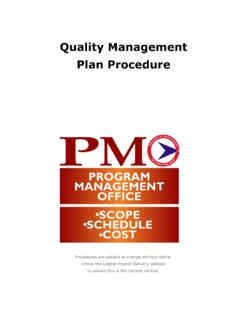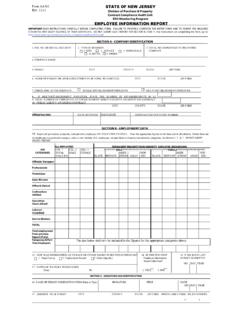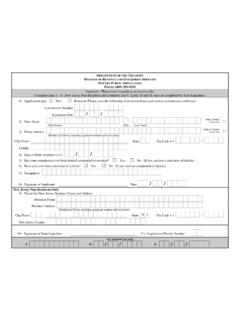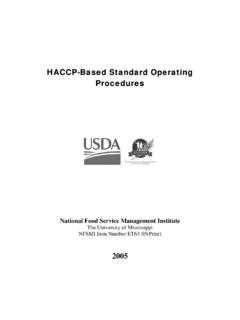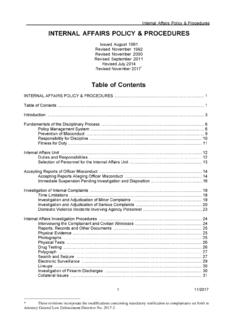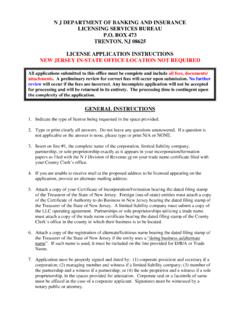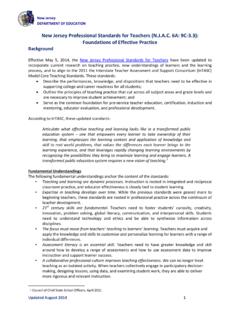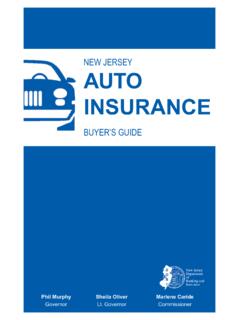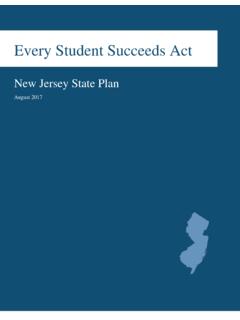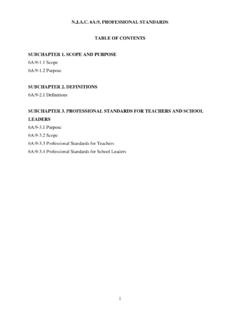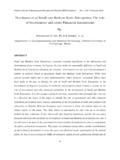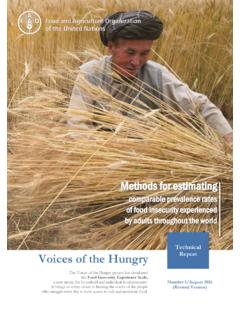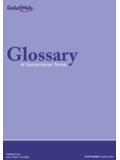Transcription of Living Below the Line - New Jersey
1 Living Below the Line:Measuring Economic insecurity Among New Jersey s Retired SeniorsNovember 2017 State of New JerseyDepartment of Human ServicesDivision of Aging Services The New Jersey Department of Human Services (NJ DHS) complies with applicable Federal civil rights laws and does not discriminate on the basis of race, color, national origin, age, disability, or sex. NJ DHS does not exclude people or treat them differently because of race, color, national origin, age, disability, or sex. The NJ DHS provides free aids and services to people with disabilities to communicate effectively with us, such as: Qualified sign language interpreters Written information in other formats (large print, audio, accessible electronic formats, other formats) Free language services to people whose primary language is not English, such as qualified interpreters Information written in other languages If you need these services, contact Bonny E.
2 Fraser, Esq., or if you believe that the NJ DHS has failed to provide these services or discriminated in another way on the basis of race, color, national origin, age, disability, or sex, you can file a grievance at: 222 South Warren Street, PO. Box 700, Trenton, New Jersey 08625 0700; phone: 609 777 2026; fax: 609 633 9610; You can also file a civil rights complaint with the Department of Health and Human Services, Office for Civil Rights, electronically through the Office for Civil Rights Complaint Portal, available at , or by mail or phone at: Department of Health and Human Services, 200 Independence Avenue, SW, Room 509F, HHH Building, Washington, 20201; phone 800 368 1019, 800 537 7697 (TDD). Complaint forms are available at with Public Law 2016, Chapter 53, mandated the NJ Department of Human Services (DHS) to annually update the New Jersey Elder Economic Security Standard Index (Elder Index).
3 The Elder Index was originally produced for New Jersey by the Gerontology Institute at the University of Massachusetts Boston, with the support of the New Jersey Foundation for Aging, in 2009, followed by updated versions for 2012 and 2014. Under the law, DHS produced reports for 2015 and 2016. As noted in the law, the New Jersey Elder Economic Security Standard Index (Elder Index) is a tool that measures the income older adults require to make ends meet and to remain in their own homes. The Elder Index and related data helps elders and policymakers quantify elder economic security; examine the components of economically secure elders basic expenses; measure how well public policies can help fill these gaps; evaluate current income support programs ability to move individuals toward economic security; calculate New Jersey s elder economic insecurity rate; and identify who is most likely to lack security.
4 The legislation calls for the DHS to use the Elder Index to improve the coordination and delivery of public benefits and services to older adults residing in New Jersey and as a planning tool to allocate resources more efficiently. State and federal agencies offer a variety of tax rebates and housing, food and energy assistance programs to help older adults to remain in their home settings. The Elder Index is a tool for future planning. The following report was prepared by the Edward J. Bloustein School of Planning and Public Policy at Rutgers, The State University of New Jersey on behalf of the DHS. Copyright New Jersey Department of Human Services, 2017 Living Below the Line 1 ew Jersey seniors face an array of economic security challenges, including employment barriers, long term care needs and large Living cost increases.
5 Over the previous decade, senior budgets nationally have been squeezed by modest wage increases,1 low returns on savings and low risk investments, and increases in prices of basic needs, including food (28%), medical care (34%), prescription drugs (40%) and rent (35%).2 To help current and future seniors, their families, and state and local government to better understand such challenges, the New Jersey Department of Human Services, Division of Aging Services presents a report on Elder Economic insecurity Rates the proportion of retired seniors whose 2015 incomes fell short of the New Jersey Elder Economic Security StandardTM Index senior specific basic needs budget. After presenting Elder Economic insecurity Rates, the report uses the Elder Index to measure economic security gaps the difference between retired seniors actual incomes and the Elder Index and demonstrates state and federal public support programs potential to fill those economic security gaps.
6 Executive Summary The New Jersey Elder Economic Security Standard Index (Elder Index) is a measure of the income retired seniors need to pay for basic monthly expenses and age in place in their communities. The Elder Index defines economic security as income sufficient to pay for basic needs housing, food, transportation, health care and miscellaneous items without borrowing, relying on financial gifts, or relying on public support programs. Seniors with incomes Below their local Elder Indexes are more likely to make difficult spending choices, to go without one or more basic need, and to have trouble remaining in their homes as they age and/or their health declines. New Jersey s statewide Elder Economic insecurity Rate (EEIR) is 54%; more than five in ten New Jersey retired elder only households lack annual incomes that will insulate them against poverty as they While such insecurity affects elders of all backgrounds, New Jersey EEIRs vary greatly by household type, housing type, race, gender and location: New Jersey elders who live alone are much more likely than elder couples to live in insecurity .
7 The statewide EEIR is 64% for single elder households, compared to 35% for elder couple households. Eighty percent of elder renter households lack economic security incomes. Nearly 54% of elder homeowners with mortgages and 40% of elder homeowners without mortgages live in insecurity . Single elder households and elder women experience particularly high insecurity rates. Sixty six percent of single N Living Below the Line 2 elder women households and 60% of single elder men households lack security incomes. Fifty three percent of New Jersey s senior women (individuals) and 43% of senior men (individuals) lack security EEIRs vary greatly by New Jersey county. The overall insecurity rate is highest in Hudson County (76%) and lowest in Hunterdon County (45%). Several counties with the state s highest EEIRs are clustered in the northeast of the state, while those counties with relatively low EEIRs are spread throughout the state.
8 Large numbers of seniors face annual economic security gaps gaps between income and the Elder Index of $15,000 or more. Like EEIRs, economic security gaps vary greatly by race and gender. The statewide EEIR for all New Jersey seniors Living in retired senior only households fell by percentage points between 2010 and 2015. EEIRs for nearly all groups studied decreased over the period; but EEIRs increased for Hispanic householders ( percentage points), renters ( percentage points) and single men households ( percentage point). Changes in insecurity rates can indicate positive change, raise red flags, and help forecast future insecurity of both current seniors and future retirees. They can also be early, senior specific indicators of imbalances between retirement incomes and local costs of Living .
9 Potential EEIR increases are in part offset by state and federal public support programs designed to stabilize poverty rates. Income eligibility limits for support programs dating back to the 1960s, such as medical and food assistance, are still percentages of the federal poverty guidelines ( , 100% FPL). The poverty guidelines also date back to the 1960s, and are blunt indicators of deprivation associated in the public mind with chronic, intractable social problems. In contrast, newer support programs, such as New Jersey s Pharmaceutical Assistance to the Aged and Disabled (PAAD), do not have income limits based on the poverty guidelines, and help participants with moderate incomes avoid poverty when they encounter health and financial crises. Expressing all support program income eligibility limits as percentages of the Elder Index reveals an assistance continuum which addresses urgent needs, helps prevent poverty, and reduces economic security gaps.
10 Once economic insecurity rates, economic security gaps and available supports are understood, the Elder Index can be used to model federal and state support programs impact on economic security gaps and EEIRs. Impacts can be modeled for individual or multiple support programs, and can be modeled for individual households, for New Jersey retired seniors as a whole, or for senior subgroups. This study demonstrates that a program such as Supplemental Nutrition Assistance Program (SNAP, formerly Food Stamps), when accessible, can reduce a senior household s economic insecurity gap by more than 11 percentage points, and that New Jersey s property tax relief programs can reduce a senior household s economic insecurity gap by more than percentage points. An economic security based approach to well being defining security needs, measuring economic security gaps, measuring programs security impacts, and regularly using the inclusive, aspirational language of senior security can lead to more seniors Living well and Living longer in their communities.
